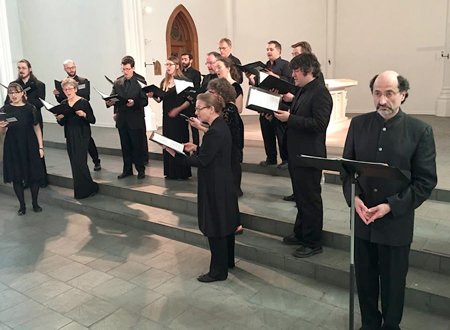by Timothy Robson

Richard Davy was master of the choristers at Oxford’s Magdalen College in the 1490s. His, the first polyphonic Passion setting by a known composer, appeared in the Eton Choirbook, a physically large collection of motets with Davy’s Passion at the end. About a third of the contents have gone missing over the past five centuries, including portions of Davy’s work.
Duffin began his reconstruction years ago as a graduate student at Stanford, filling in the missing parts by adapting and reusing music found elsewhere in the work. He has also replaced Davy’s original Latin text with an English translation by William Tyndale, a slightly later theologian at Magdalen College. Some might quibble with this textual inauthenticity, but the English text makes for a more compelling and involving listening experience.
The music is austere, befitting its intent for a Holy Week liturgy. Two soloists, a tenor (the narrator or Evangelist) and a baritone (Jesus), chant the biblical text in the historical manner of Salisbury Cathedral (Sarum Rite). The chorus sings polyphony, sometimes straightforward, at other times florid and complex, representing the other characters in the drama (Peter, the chief priests, the crowd). There is no accompaniment, and there are no inserted arias — as in the Bach passion settings. The stark white interior of St. Peter’s Church fit the somber nature of the work, and its reverberant acoustics gave the sound a magnificent bloom.
The performance was riveting musically and dramatically. Quire’s sound was focused and unfailingly in tune over the 45-minute span of the work. It is rare to hear voices blend so purely that they emanate harmonic overtones.

Like contemporary minimalist music, small changes took on significance in the context of otherwise similar music. And though the complete text was printed in the program booklet, soloists and choir were almost always understandable without referring to it.
Without pause, Quire Cleveland followed Davy’s Passion with an Easter carol, Ah, Gentle Jesu, by a composer known only as Sheryngam, who was active about 1500. It is a lengthy work in five stanzas, a meditation on the crucifixion, with a refrain asking for the Savior’s mercy.
This performance confirmed Quire Cleveland’s the reputation as one of the best choral ensembles in the area. Davy’s St. Matthew Passion deserves to take its place alongside the Passions of similar scale by the German Baroque composer Heinrich Schütz. The musical and religious value of Davy’s work was confirmed by its masterful resurrection and reconstruction by Ross Duffin.
Published on ClevelandClassical.com April 17, 2017.
Click here for a printable copy of this article



